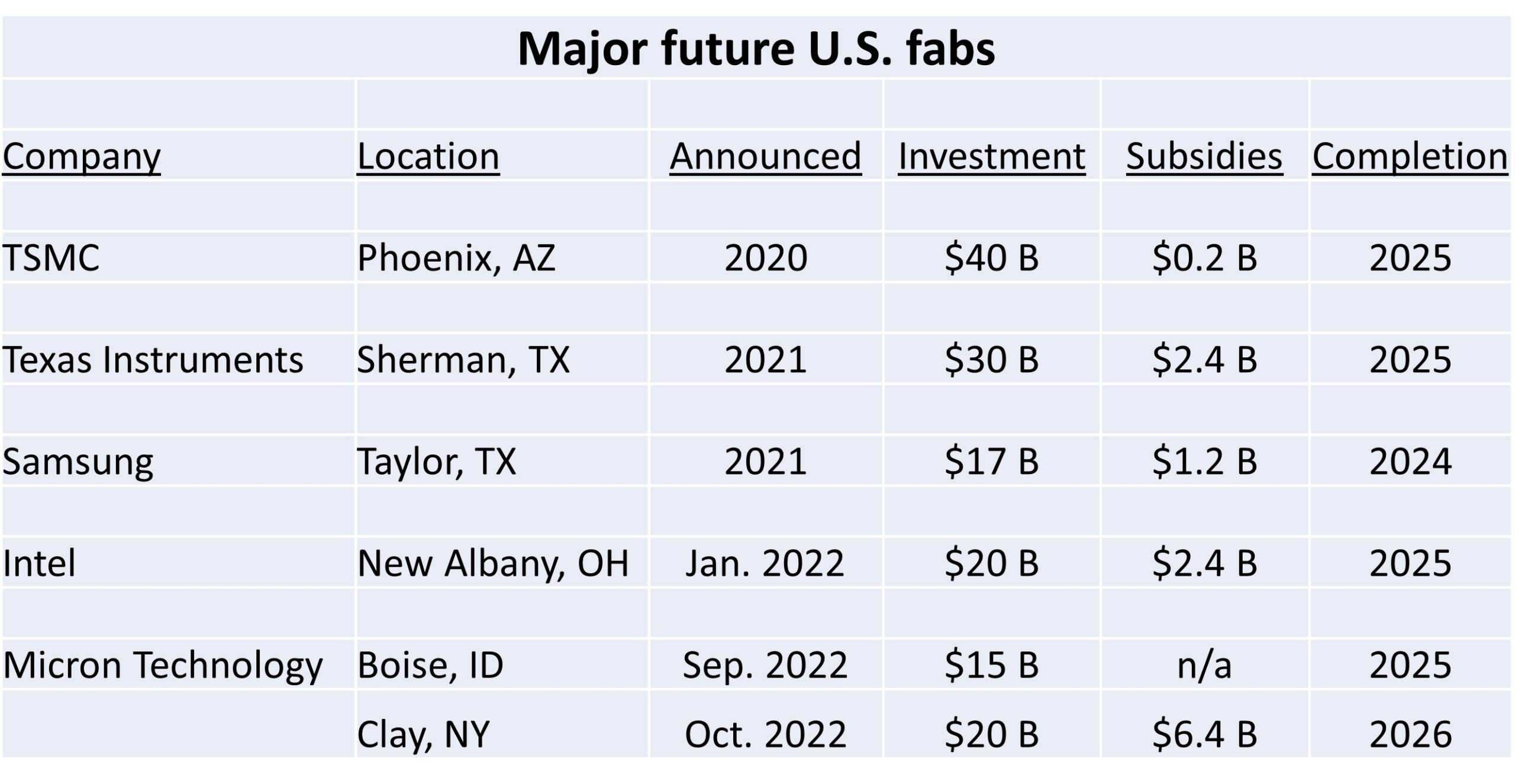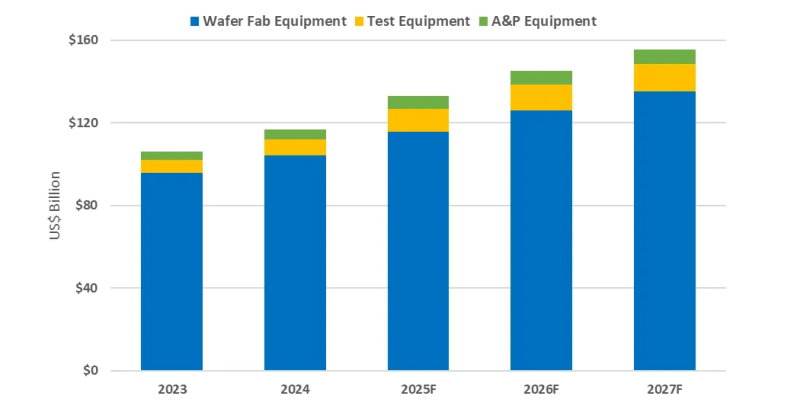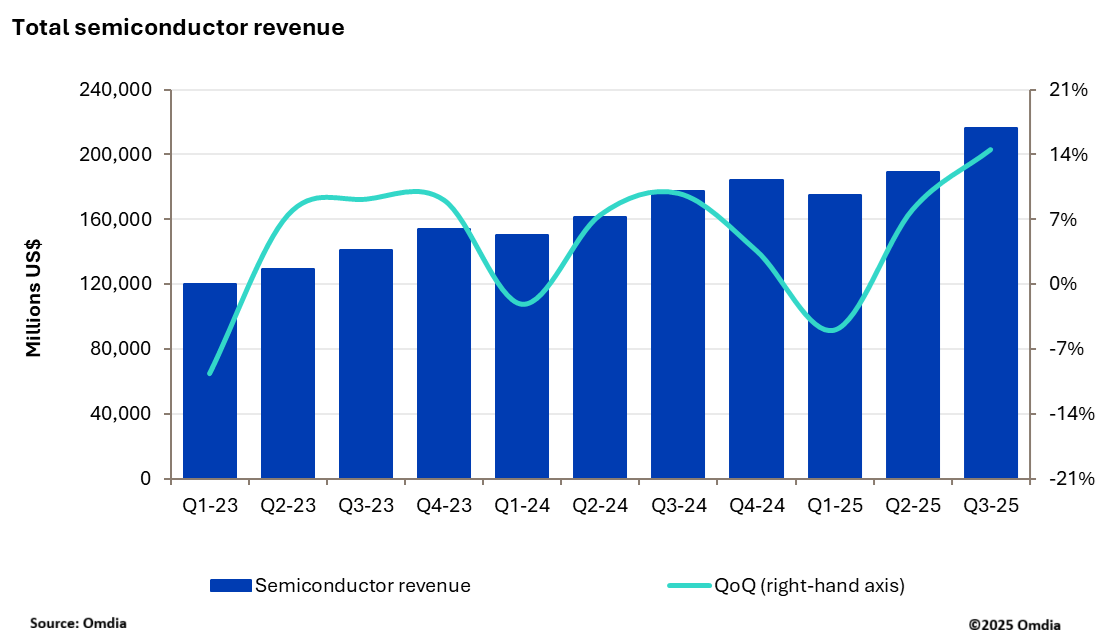Has the US Chips Act been successful in increasing investment in semiconductor wafer fabs in the U.S? asks Semiconductor Intelligence.
SI’s answer is the table below of major U.S. fab projects announced in the last few years.
The total near term investment is $142 billion. Most of these projects were announced before the passage of the Chips Act.
However, these companies likely expected future U.S. government subsidies. The subsidies listed in the table are from state and local governments. The organization Good Jobs First tracks government financial assistance to business.

Would these fabs have been built in the U.S. without the expectation of U.S. government assistance? Let’s look at each company.
TSMC – the largest semiconductor wafer foundry, based in Taiwan. TSMC has six current 300mm wafer fabs. All are based in Taiwan except for one in Nanjing, China.
TSMC’s third quarter 2023 report shows 69% of its revenue came from companies based in North America (primarily the U.S.). TSMC has been facing pressure from both the U.S. government and its U.S. customers to build a fab in the U.S.
This pressure combined with the hope of U.S. government funding most likely drove its decision to build a fab in Arizona. TSMC is reportedly seeking about $15 billion in funding through the CHIPS Act. TSMC is also planning an $11 billion wafer fab in Dresden, Germany in a joint venture with Bosch, Infineon and NXP.
The German government planned to contribute about 5 billion Euros ($5.4 billion) towards the fab. However, a recent court ruling places the German subsidies in doubt.
Texas Instruments – TI currently has 300mm wafer fabs located in Dallas, Texas; Richardson, Texas; and Lehi, Utah.
The Lehi fab was purchased from Micron Technology and converted by TI to produce analogue ICs. TI in the past has located fabs in Europe and Asia, but in the last several years has only build fabs in the U.S. TI’s proposed fabs in Sherman, Texas are about a one-hour drive from TI’s headquarters.
TI has had operations in Sherman for over 50 years. The city, school district, and county will provide about $2.4 billion in subsidies for the Sherman fabs, primarily through tax breaks.
Any money TI receives through the CHIPS Act will be a bonus. However, it is likely TI would have built its new fabs in Sherman without the CHIPS Act.
Samsung – Most of Samsung’s fabs are in South Korea. Samsung built a fab in Austin, Texas which opened in 1996. The Austin fab operates as a wafer foundry.
Samsung’s announced fab in Taylor, Texas – about 45 minutes from Austin – will also be a wafer foundry. The company will continue to make major fab investments in South Korea with $230 billion planned over the next 20 years, primarily for memory fabs.
Samsung will receive about $1.2 billion in local subsidies from Taylor area governments. The proximity to its Austin fab and the local incentives were most likely the primary drivers for Samsungs Taylor fab.
Funds from the CHIPS Act were probably also a factor, but Samsung presumably would have built the fab in Taylor without CHIPS money.
Intel – Intel has major U.S. fabs in Chandler, Arizona; Hillsboro, Oregon; and Rio Rancho, New Mexico. It also has fabs in Leixlip, Ireland; Jerusalem, Israel; and Kiryat Gat, Israel.
Intel is building a new fab in Kiryat Gat with about $3 billion in Israeli government subsidies. The company also plans a fab in Magdeburg, Germany with about $11 billion in German government aid. However, as with TSMC, the German funding is uncertain.
Intel will receive about $2.4 billion in local aid for its fab in New Albany, Ohio. Intel announced the Ohio fab in January 2022 – before the CHIPS Act was passed but when passage appeared likely. Intel has shown a willingness to locate fabs outside of the U.S. for the right incentives. The CHIPS funds were certainly a major factor in deciding on the Ohio location.
Micron Technology – Micron has fabs in Boise, Idaho; Taichung, Taiwan; Hiroshima, Japan; and Singapore.
The foreign fabs were all procured through Micron business acquisitions: Rexchip Electronics in Japan, Intotera Memories in Taiwan, and Texas Instruments’ memory business in Singapore. Micron plans to expand its fabs in Taiwan and Japan.
The Japanese government will subsidize Micron’s new Hiroshima fab with about $1.3 billion. Micron will build new fabs in Boise, Idaho and Clay, New York over the next several years. Micron will receive about $6.4 billion in state and local incentives for its New York fabs.
The new fabs will produce DRAMs, which Micron currently makes only in Taiwan and Japan. Micron’s strategy is to eventually produce 40% of its DRAMs in the U.S. The new U.S. fabs were announced in September and October of 2022, well after the passage of the CHIPS Act.
Since Micron has shown a willingness to expand its overseas fabs, the CHIPS funds were undoubtedly a major factor in deciding on its Idaho and New York fabs.
In summary, was the CHIPS Act a deciding factor in locating these new fabs in the U.S.? Asks SI.
We say yes for TSMC and probably for Micron and Intel, answers SI. TI and Samsung would likely have made their fab location decisions without the CHIPS Act. It remains to be seen how the CHIPS Act will affect future fab decisions.
Companies decide to build new fabs based on their anticipated capacity needs. Fab locations are based on many factors including proximity to company headquarters, infrastructure, workforce, political stability, customer proximity, and logistics.
Government subsidies may influence the country for the fab and the location within the country but are generally not the primary driving factor.
The SI June estimates for 2023 semiconductor capex were about $156 billion, down 14% from 2022. Most companies appear to be holding to their plans.
One exception is Intel, which we had estimated at $20 billion in 2023 CapEx. Through the third quarter of 2023, Intel capex was $19.1 billion, which means the full year will likely be around $24 billion.
The largest spender, TSMC, confirmed in October their 2023 capex target of $32 billion, down 12% from 2022.
Few companies have indicated their capex plans for 2024.
Micron ended its 2023 fiscal year in August with $7.0 billion in capex. Their guidance for fiscal 2024 capex was “slightly above” fiscal 2023.
Infineon’s fiscal year 2023 ended in September with 3 billion euro ($3.2 billion) in capex. Infineon plans to increase capex to 3.3 billion euro ($3.6 billion). The SI preliminary estimate for 2024 total capex is a 10% to 20% increase from 2023, in the range of $172 billion to $187 billion.
Stay up to date with the latest in industry offers by subscribing us. Our newsletter is your key to receiving expert tips.

Worldwide semiconductor equipment sales are projected to grow 13.7 percent in 2025, reaching a record 133 billion dollars, Semi announced at Semicon Japan. This momentum is expected to continue throug

The smartphone industry is facing considerable cost challenges in 2026 amid ongoing memory supply shortages and rising prices. This situation is expected to lead to a 1.6% decrease in annual shipments

New research from Omdia shows that the semiconductor market delivered a record breaking performance in 3Q25 with industry revenue reaching $216.3bn, up 14.5% quarter-over-quarter (QoQ). This marks the